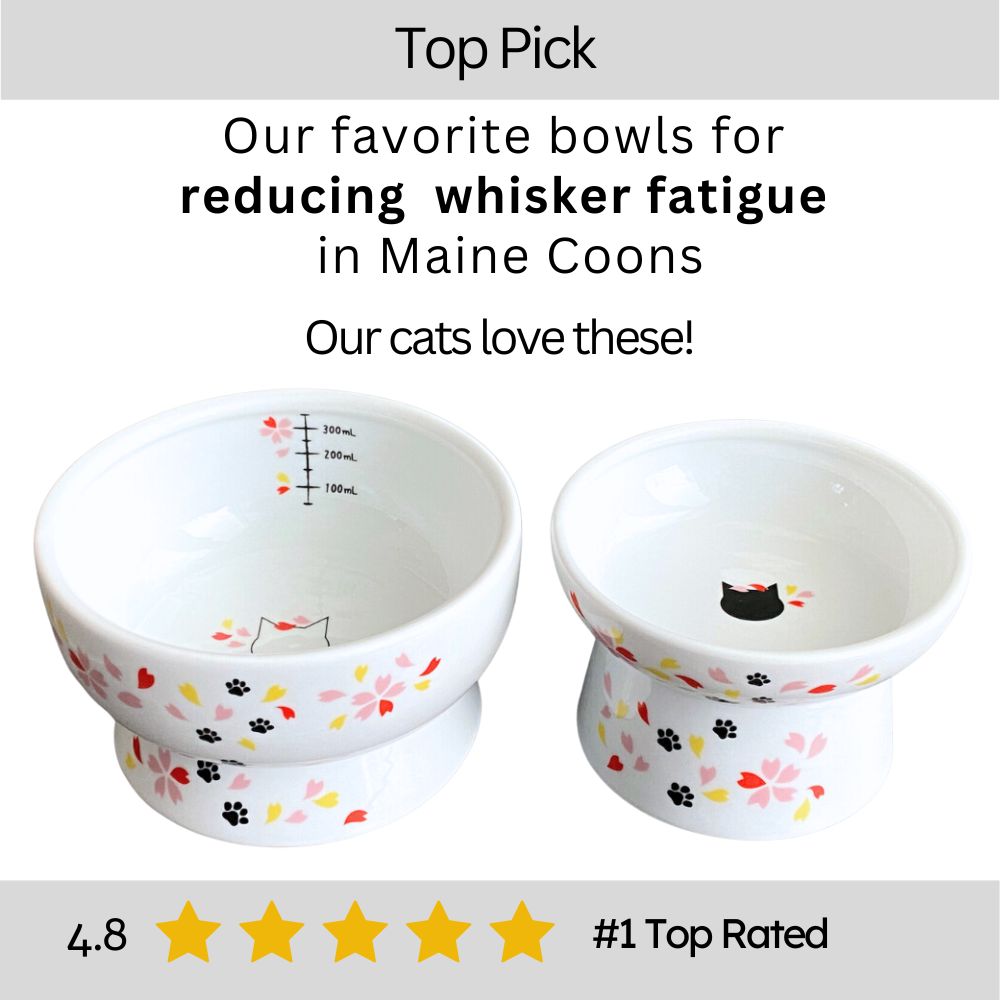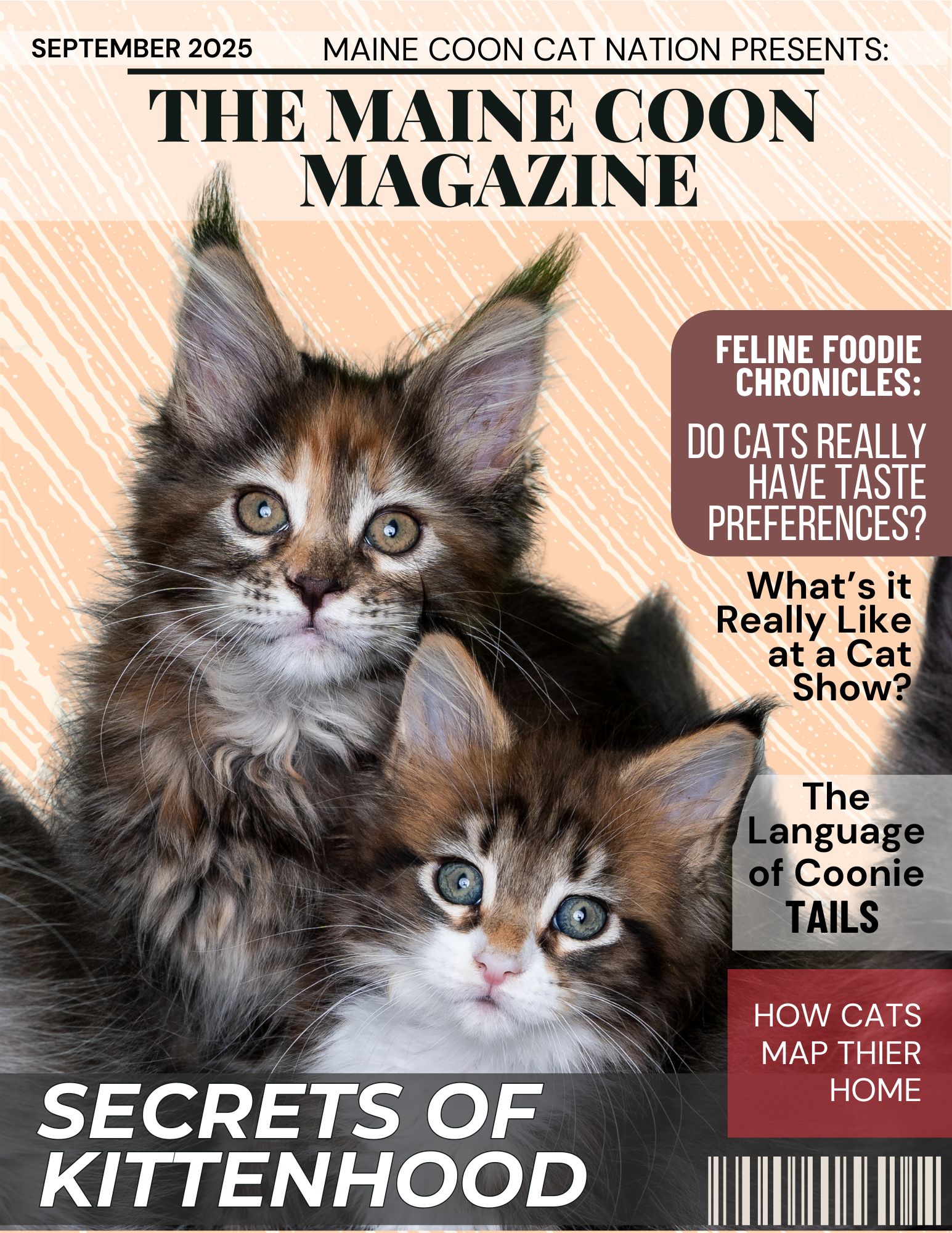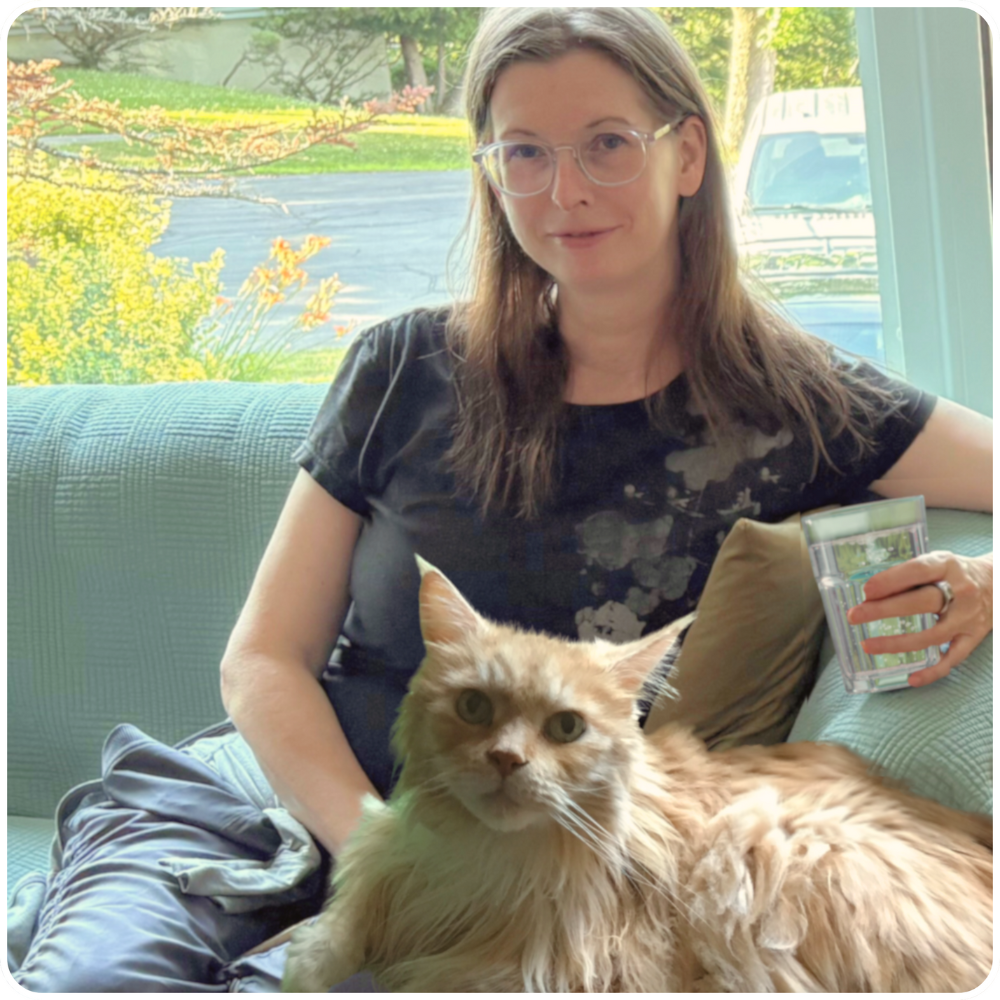- Home
- Maine Coon Food
- Free Feeding Cats
Free Feeding Cats
6 Common-Sense Reasons This Works
With the formidable size of Maine Coons and their late-blooming status, folks often ask, "How much should I be feeding my Maine Coon?" It's an important question - especially when it comes to free feeding cats.
If you like this, you'll love our fun, free Daily Digest!

Kittens and young cats need plenty of food to fuel their growth, but with such a large breed, how much is enough?
Sometimes it seems like they’re always hungry! And no matter their age, many pet parents worry about overfeeding or maintaining a healthy weight.
Personally, I’ve found that free feeding works best for my Maine Coons. My reasons are rooted in both common sense and observation, though almost all of them come with a caveat or two.
#6: Letting Nature Lead The Way:
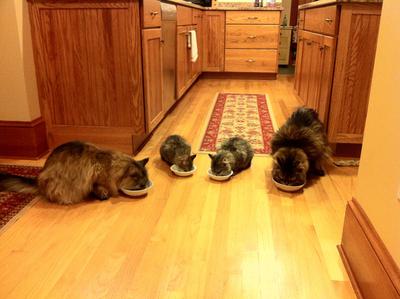 Marley, Beppi, Luca and Arthur at dinner time!
Marley, Beppi, Luca and Arthur at dinner time!Who came up with this measuring idea, anyway?
We don’t measure the amount of food we give to human babies and children - so why should we micromanage how much our feline companions eat?
In the wild, cats naturally free-feed. Feline mothers, whether domesticated or wild, don’t ration food for their kittens or cubs.
And back in the days before pet stores and paved streets, no farmer was reaching for a measuring cup to dole out precise portions to the family’s trusted mouser.
Of course, there’s a caveat. Wild cats stay active by necessity, hunting and roaming over large territories.
For our indoor companions, it’s up to us to ensure they don’t become couch potatoes. When free feeding cats, regular playtime is essential, even when they’re fully grown!
Another consideration is diet. Unlike wild prey, most processed cat food is calorie-dense and doesn’t provide the same nutritional balance as a fresh, raw diet.
Incorporating high-quality canned food or other wet options can help offset this difference and keep your kitty healthy.
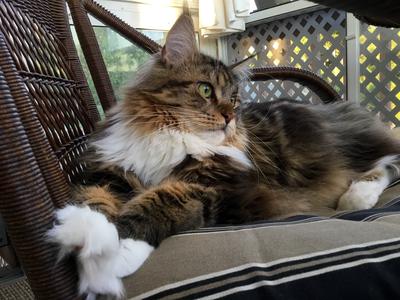
#5: Every Body Is Different
Think about it: a one-year-old Maine Coon might weigh the same as a senior domestic shorthair. But does that mean they should be eating the same amount?
Strictly following the measurement guidelines printed on pet food packages might leave your cat unsatisfied - or even overfed.
Those recommendations are a one-size-fits-all approach that doesn’t account for individual differences, like age, activity level, or metabolism.
That said, there are times when portion control is necessary. For example, your vet might recommend a measured approach to manage weight or health conditions.
In those cases, it’s important to follow their guidance. But in many cases, free feeding cats allows them to eat based on their natural hunger cues.
Even rehomed kittens can grow into gentle giants. See what to expect in terms of Maine Coon growth and size, from early weeks to full-grown adults.
#4: Changes In Appetite
Some days, I feel like I could eat everything in the fridge. Other days, I barely finish dinner.
My son is the same way - sometimes he eats like a bird, and other times, he’s raiding the kitchen for snacks like a teenager in the middle of a growth spurt.
I’ve noticed similar patterns with my feline companions. Their appetites ebb and flow with the seasons, their activity levels, and even their age.
By free feeding my cats, I let them decide how much food they need each day. Both are healthy and happy, so I trust their instincts.
#3: Tendency To Hoard
When there’s a limited food supply, competition is bound to happen - especially in households with multiple pets. This kind of stress isn’t good for anyone, least of all your kitty.
One of the biggest reasons I believe in free feeding cats is to prevent anxiety around food.
When the bowl was empty (which was rare), Leo would worry. He’d then scarf down the food as soon as we refilled his dish, eating so quickly that he vomited - every single time.
Even worse, an empty bowl pushed him to raid the dog’s food, which was not good for his health.
Keeping the food dish full eliminated this behavior and helped him feel secure.
The Caveat: If the bowl ever did run empty, I'd have to offer Leo very small portions in succession until he lost interest. Otherwise, he’d eat too quickly and make himself sick again.
#2: 'Fat Cats' Aren’t as Common in Maine Coons as You Might Think
New Maine Coon parents often worry that their kitty’s large size might predispose them to becoming "fat cats."
But the truth is, Maine Coons are naturally well-proportioned and built to be big - big paws, big heads, long, strong bodies, and plenty of muscle.
A feline with a large proportion of muscle will weigh more than one of the same size with less muscle.
That said, no cat is immune to overeating. Occasionally, some owners may overfeed their Maine Coon or mix in an attempt to hit an impressive weight milestone.
This can backfire, as carrying excess weight puts unnecessary stress on their hips and joints, which are already supporting a larger frame.
For Maine Coon mixes, this risk is even greater. These feline friends might have the friendly personality and medium-length fur of a Maine Coon, but not the bone structure or frame to handle the extra pounds.
Free feeding cats works well when paired with regular monitoring - make sure your big kitty stays active and healthy to avoid weight-related issues.
#1: Practicality
When Alice and Leo were with us, free feeding was an absolute necessity in our home.
Like many cat owners, I had multiple cats with very different needs - one was petite, the other quite robust.
On top of that, we were a busy household with kids and work keeping us on the go.
The idea of separating them into different rooms, measuring their portions, and supervising mealtimes multiple times a day just wasn’t realistic.
And honestly, even if I’d tried, I think they would have ended up eating the same amount anyway!
Free feeding cats gave us the freedom to meet their needs while also keeping up with the demands of daily life.
On longer workdays, I knew they wouldn’t go hungry, and they always seemed much happier being able to graze on their own schedule.
Questions & Concerns About Free Feeding Cats
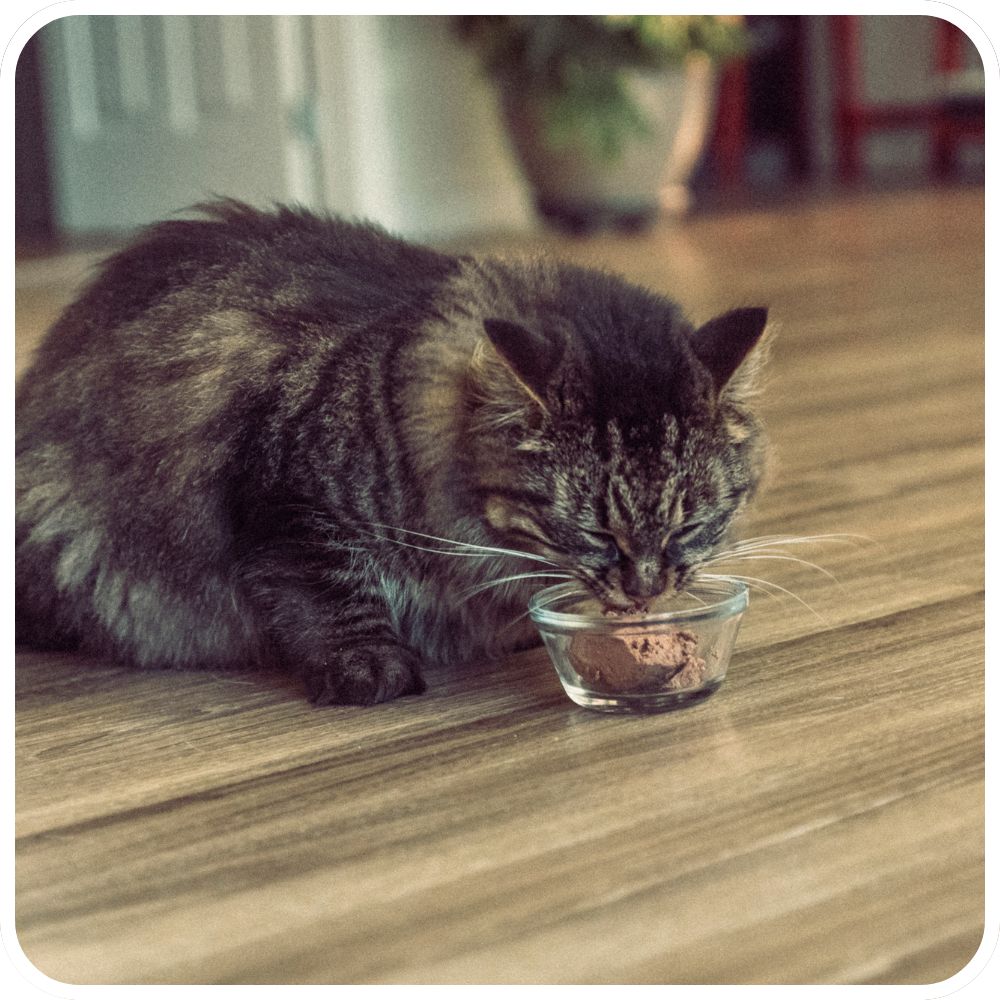
When it comes to free feeding cats, some pet parents have a few valid questions or concerns.
Let’s take a closer look at some of the most common ones - and how to manage them.
"Won’t my cat overeat?"
"Won’t my cat overeat?"
It’s a fair concern, especially if you’ve seen your kitty scarf down a full bowl of kibble in one sitting.
However, most cats are natural self-regulators when it comes to food.
Overeating usually stems from food anxiety (when they’re unsure when their next meal will come) or boredom.
Free feeding cats helps eliminate this anxiety, as food is always available when hunger strikes.
That said, if you have a feline friend who tends to snack out of boredom, focus on providing plenty of stimulation - interactive toys, climbing spaces, and regular playtime.
This way, their energy goes toward burning calories, not piling them on.
"What if I have a kitten and an adult cat?"
"What if I have a kitten and an adult cat?"
This is a common scenario for multi-cat households. Maine Coon kittens, in particular, need calorie-dense food to fuel their rapid growth, while adults require fewer calories to maintain a healthy weight.
To accommodate both, you could create a high feeding station or a separate space where your kitten can enjoy its meals in peace, away from older cats.
With a little creativity, free feeding can work for all ages in your home.
"Is free-feeding more expensive?"
"Is free-feeding more expensive?"
The initial investment in high-quality kibble might seem more costly, but it’s important to think long-term.
Choosing a balanced, nutrient-rich diet helps maintain their health and can prevent costly vet visits later.
You can also manage your budget by buying in bulk or looking for discounts on trusted brands.
To make free feeding cats more economical, consider supplementing with affordable canned food or other nutritious options, so your kitty gets a varied diet without breaking the bank.
With Maine Coons, you might find they’re not just eating more - they’re also thriving more.
Top Tips For Free Feeding Cats
This can be a convenient and effective approach, but setting it up for success takes a little planning. Here are some actionable tips to make work well in your home:
Choose the Right Kibble
The foundation of a successful free-feeding system is high-quality, species-appropriate kibble.
Look for options with real meat as the primary ingredient, minimal fillers, and added nutrients to support your cat’s overall health.
Maine Coons, in particular, benefit from nutrient-dense foods that cater to their larger size and active nature.
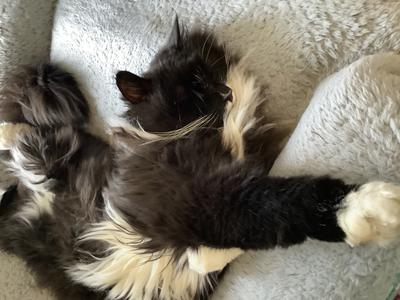
Prevent Overeating with Enrichment
To avoid overeating, pair free-feeding with plenty of opportunities for activity. Puzzle feeders, interactive toys, and regular play sessions can keep your feline companion engaged and help burn calories.
For large kitties, climbing trees or engaging in "hunt" games mimics their natural instincts and adds an extra layer of stimulation.
Manage Multi-Cat Feeding Dynamics
In households with more than one cat, it’s important to prevent competition over food.
Provide multiple food stations throughout the house to ensure everyone has access without feeling rushed or anxious.
If you have cats on different diets, consider using microchip-activated feeders to ensure each one gets what they need without stealing from their sibling’s bowl.
Maintain Freshness
Keep the kibble fresh by using airtight storage containers and refilling bowls with smaller portions throughout the day.
This prevents staleness and ensures your cats always have appetizing food available.
Monitor Weight and Adjust as Needed
While free-feeding works well for most cats, it’s still important to monitor their weight and body condition.
If you notice your kitty packing on extra pounds, make adjustments - whether it’s reducing the kibble portion slightly or increasing their playtime.
Unique Maine Coon Needs
Our beloved breed is unlike most other cat breeds in many ways, and their feeding needs reflect this.
Incorporating free-feeding into your routine can offer several specific benefits tailored to their unique characteristics:
Supporting Their Long Growth Period
Maine Coons grow much slower than other cats, often not reaching full size until they’re 3 to 5 years old.
Having food available throughout the day ensures they can meet their nutritional demands during this extended growth phase, especially during growth spurts.
Accommodating Their Large Appetites
As one of the largest domestic breeds, Maine Coons naturally eat more than smaller cats.
Letting them graze at their own pace ensures they can satisfy their hunger without feeling rushed or stressed at mealtime.
Preventing Energy Dips
These highly active and playful cats burn a lot of calories throughout the day. Regular access to food helps them refuel as needed, supporting their energetic nature.
Considering Their Bone and Joint Health
Due to their larger size, Maine Coons are more prone to joint issues as they age. Giving them a high-quality diet with joint-supporting nutrients like glucosamine and chondroitin is key.
Allowing steady access to nutritious food helps maintain their weight and avoid unnecessary strain on their joints.
This method works for us. But whether it works for you is completely up to you and your Maine Coon.
Every fur-family, and every Maine Coon is unique. I strongly feel that being in tune with your cat is crucial.
No one knows better than you whether he or she is happy, healthy and content!
